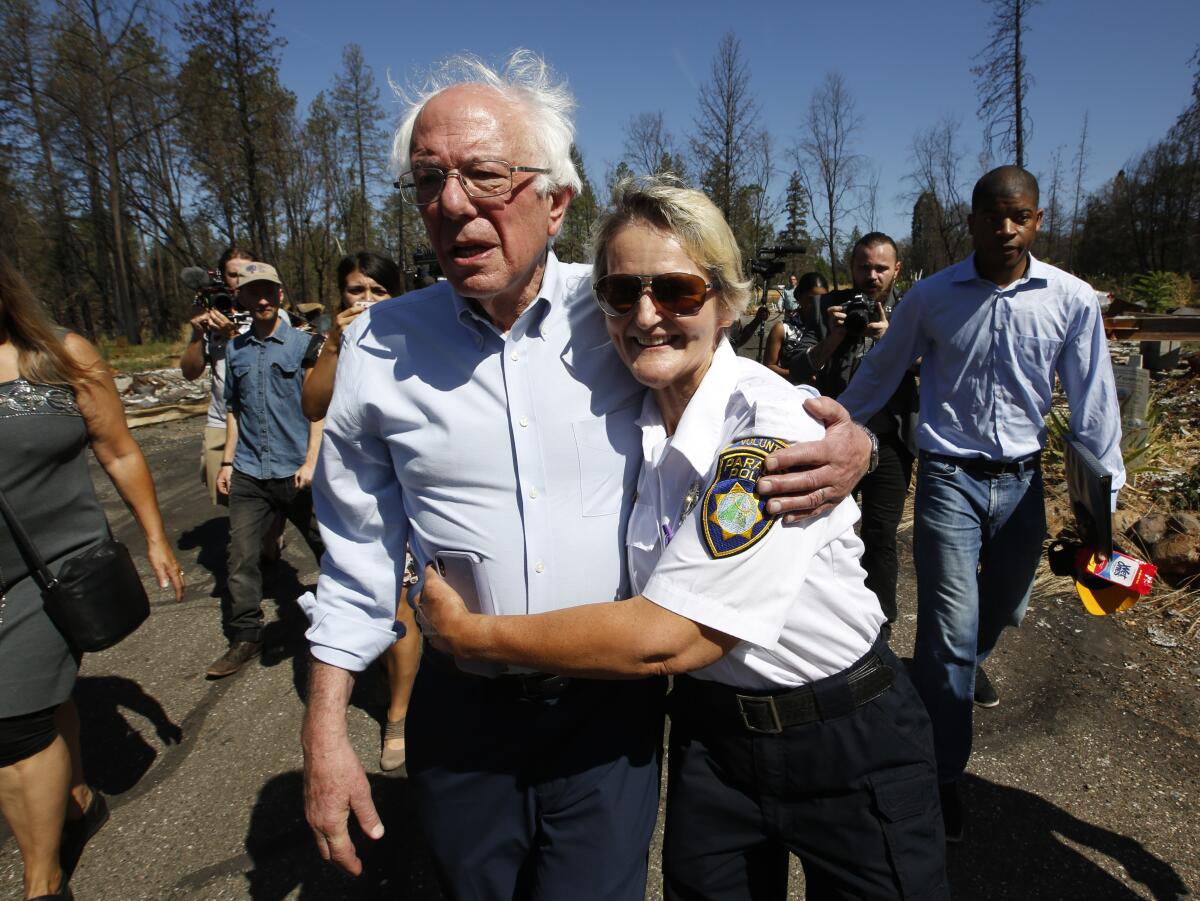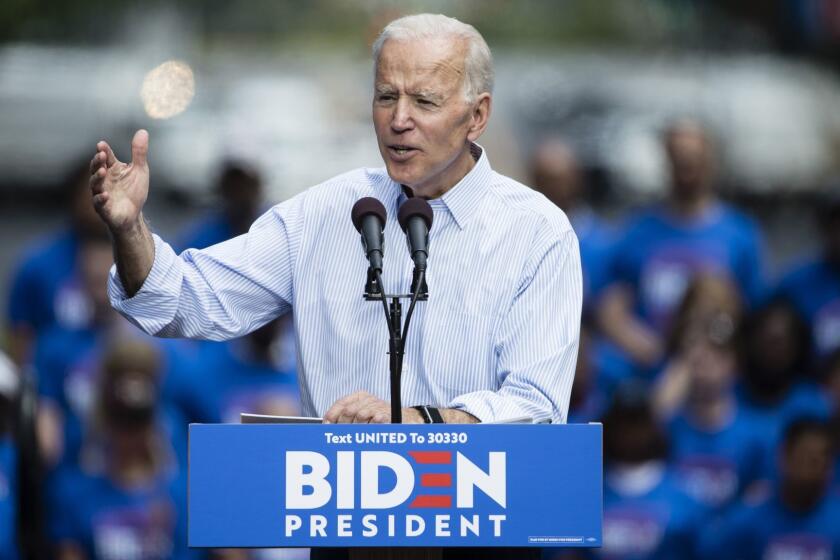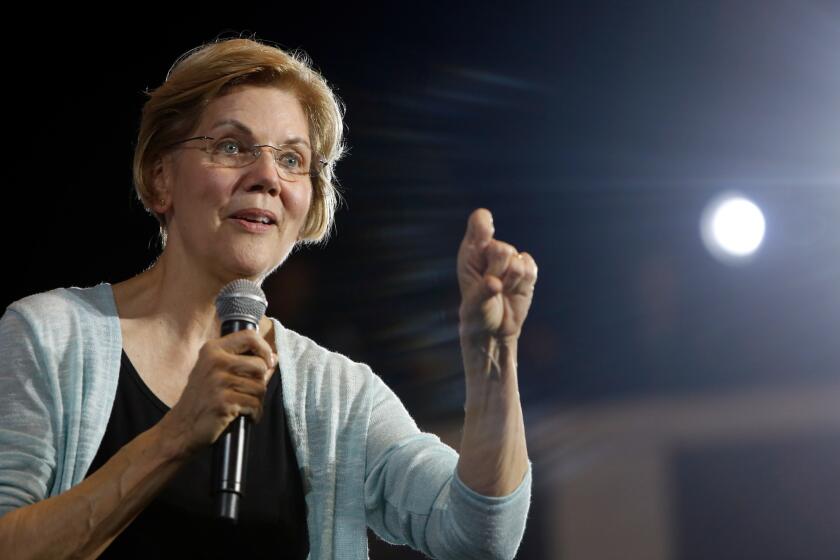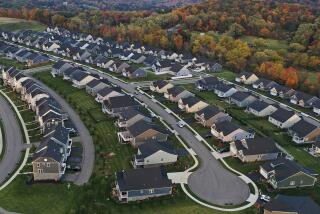Bernie Sanders talks about ‘silver linings’ and his climate change plan in fire-devastated town

- Share via
PARADISE, Calif. — Surveying the ruins of a mobile home park incinerated in November here in the deadliest wildfire in California history, Bernie Sanders said there could be a “silver lining” to the tragedy: public understanding “that we need bold and aggressive action to combat climate change.”
“We’re fighting for the future of the planet,” the Vermont senator said Thursday as he walked amid blackened pine trees towering over burnt and rusty pickup-truck frames and armchair springs.
Sanders used the backdrop of Paradise, a town nearly destroyed in a fire that killed 86 people, to introduce his sweeping $16-trillion plan to fight global warming. Sanders became the latest Democratic presidential candidate to advance a climate change agenda that would have a far-reaching impact on the day-to-day lives of all Americans. His is the costliest by far.
“It is expensive but the cost of doing nothing is far more expensive,” Sanders told supporters later Thursday at a forum in nearby Chico.
Sanders compared his proposal to President Franklin D. Roosevelt’s New Deal programs to recover from the Great Depression and America’s mobilization to fight World War II. He predicted it would create 20 million jobs, despite the long odds that the Senate, now controlled by Republicans, would adopt even a small fraction of the plan.
Recalling the Apollo 11 mission that put men on the moon 50 years ago, the proposal says, “We can sure as hell transform our energy system away from fossil fuels to 100% renewables today and create millions of jobs in the process.”
With solar, wind, geothermal and other renewable power sources, the plan says, the U.S. can achieve 100% sustainable energy for electricity and transportation by 2030.
On his visit to Paradise, Sanders spoke with Susan Dobra, 64, who recalled President Trump visiting the town and mistakenly referring to it as “Pleasure.” The editor and teacher, a Sanders supporter who lost neighbors in the Camp fire, told reporters that Trump “stood in the ruins of our town and denied that climate change is real. But it is real and you can see the effect of it all around you.”
Sanders also met with Allen Myers, a 35-year-old filmmaker. Myers’ family lost the home where he grew up near the mobile home park.
“This is a climate-driven fire,” said Myers, who also knew people killed in the disaster. “It’s not a problem for the future, it’s happening right now.”
Scientists say climate change is lengthening wildfire seasons and increasing the heat and drought that can fuel the blazes.
Standing alongside Myers, Dobra and several other fire survivors, Sanders criticized Trump, who rejects the science showing that humans’ burning of fossil fuels is a cause of climate change.
“We have a president of the United States who thinks climate change is a hoax; President Trump is dangerously, dangerously wrong,” he said, warning of a widespread climate crisis. “One of the manifestations of that crisis is what happened here in Paradise, Calif.”
“If there’s any silver lining in this terrible tragedy in this beautiful town is that, I hope, the people of the United States, the people of the world, understand that we need bold and aggressive action to combat climate change.”
Highlights of the plan include $2.2 trillion in spending on need-based grants to families and businesses to weatherize homes and businesses; $2.1 trillion to help people replace gasoline-fueled cars and trucks with electric vehicles; $526 billion to rebuild the U.S. electricity grid; and $407 billion to buy electric buses for schools and other public transit.
If Joe Biden had been inclined to take a middle-of-the-road approach toward climate change, he’s abandoned it, judging by the proposal he unveiled Tuesday — an aggressive $1.7-trillion, 10-year plan to combat warming that goes considerably further than the environmental agenda of the Obama White House.
Sanders was less specific about how he would pay for the plan. He said he would stop federal subsidies for the fossil-fuel industry and force it to pay for its pollution through lawsuits and unspecified taxes.
He said he would also scale back military spending that’s aimed at maintaining oil dependence, generate new income tax revenue from the 20 million new jobs he says he’d create and require wealthy Americans and big corporations to “pay their fair share.”
Sanders would also ban imports and exports of fossil fuels and prohibit fracking and mountaintop-removal coal mining. He vowed a “fair transition” for displaced coal miners and other fossil fuel workers, such as five years of unemployment insurance, job training, housing assistance and healthcare.
Leah Stokes, an assistant professor at UC Santa Barbara who specializes in climate and energy politics, described the proposal as very ambitious and a bit unrealistic.
“I think implementing this plan would be really difficult,” she said.
She cited the challenge of building an almost entirely new electric grid, with environmental assessments required on virtually every wind and solar project.
At the same time, she said, the fact that Sanders, Massachusetts Sen. Elizabeth Warren, former Vice President Joe Biden and other Democrats in the race have backed bold climate plans speaks to the potency of recent youth-driven activism on climate change.
“The moral authority that young people have is just extremely powerful, and I think they are communicating the stakes in a realistic way to generations that have been completely negligent on this issue and hoodwinked by the fossil fuel industry,” Stokes said. “We have already wasted four decades, so the stakes are really, really high.”
Democratic presidential candidate Sen. Elizabeth Warren got a robust reception in the cavernous Shrine Expo Hall on the USC campus on Wednesday.
President Trump has abandoned the global Paris agreement on climate change and sought to dismantle the climate protections put in place by President Obama.
Climate change has become one of the top concerns of liberal Democrats over the last several years, particularly among young people, polls show. Although it remains a source of little or no concern to many Republicans, more and more Democrats and independents have been seeing global warming as a concrete threat as wildfires and storms become more deadly and as chronic high-tide flooding hits Miami Beach and other low-lying coastal areas.
“Each of the candidates is now responding to the fact that the base of their party is keenly interested in this issue,” said Anthony Leiserowitz, director of the Yale Program on Climate Change Communication.
California Sen. Kamala Harris, who has not yet released her climate agenda, was going to skip a CNN town hall on climate change on Sept. 4, citing a scheduling conflict. But after Sanders, Biden, Warren and other rivals agreed to participate, Harris wound up canceling two planned appearances at L.A. fundraisers so she could join them.
“We were happy to change our schedule to accommodate such a critical conversation,” Harris spokeswoman Lily Adams said. “As Sen. Harris has said, this is a climate crisis and is one of the most urgent reasons we need a new president.”
Washington Gov. Jay Inslee is ending his bid for the Democratic presidential nomination.
Washington Gov. Jay Inslee made climate change the main focus of his campaign, but dropped out of the race Wednesday night after failing to gain substantial support for his candidacy.
“I believe we are going to have a candidate to fight this battle,” he told MSNBC.
More to Read
Get the L.A. Times Politics newsletter
Deeply reported insights into legislation, politics and policy from Sacramento, Washington and beyond. In your inbox three times per week.
You may occasionally receive promotional content from the Los Angeles Times.














